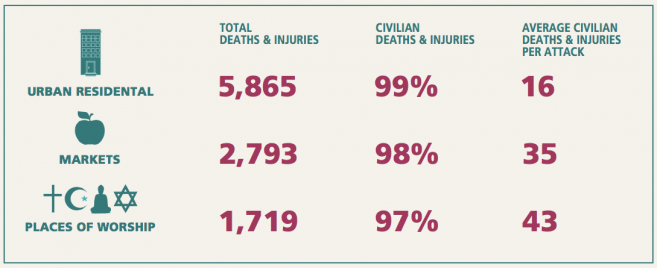Today, Action on Armed Violence (AOAV) released the annual report of their Explosive Violence Monitoring Project, which monitors deaths and injuries from the use of explosive weapons around the world as reported by English language media sources.
Once again, the data shows the heavy toll of the use of explosive weapons on civilians, in particular when these are deployed in populated areas. According to AOAV’s 2016 data, when explosive weapons were used in populated areas, 92% of those killed and injured in these incidents were civilians. In other areas, 25% of those killed and injured were reported to be civilians.
The disaggregation of this data by certain types of locations hit emphasises these stark impacts further: where explosive weapons were recorded as used in residential areas, 99% of reported casualties were civilians. Where AOAV were able to code in their data that armed actors had been the target of an incident based on the available information, in populated areas 65% of the casualties across these incidents were still civilians. Civilian deaths and injuries in populated areas represented 89% of all reported deaths and injuries.

Infographic © Action on Armed Violence
In 2016, AOAV recorded the highest number of civilian deaths around the world from the use of explosive weapons since it began monitoring casualties in 2011, and an increase of 7% on 2015. Incidents of explosive weapons use causing casualties were recorded in 70 countries by AOAV in 2016, with an average of 2,674 civilian casualties recorded every month. In total, AOAV recorded 45,624 deaths and injuries from 2,300 incidents in 2016, with 70% of these casualties reported to be civilians – 32,088 people. Syria saw the highest number of reported casualties from explosive weapons last year, followed by Iraq, Yemen, Afghanistan and Turkey.
AOAV’s report “Explosive Truths: Monitoring explosive violence in 2016” recommends that states should stop using explosive weapons with wide area effects in populated areas, and that they work to develop stronger international standards on explosive weapons use.
States are currently working to develop a political declaration as a step towards protecting civilians from the use of explosive weapons in populated areas – an initiative that the previous UN Secretary-General urged all to participate in. AOAV recommends that states work towards the full realisation of the rights of victims, and should make available data on the impact of explosive weapons – commitments that should be included in the declaration. As the report notes, states have taken steps in the past nationally to restrict certain patterns of explosive weapons use in order to better protect civilians – national policies and practices can support the development of ways forward.
Given the pattern of direct harm that AOAV’s research has consistently documented, along with a wide range of other evidence of short and long term harm to civilians from this practice, it is clear that states and others must take urgent action to protect civilians from the use of explosive weapons in populated areas.
Read more
Explosive truths: Monitoring explosive violence in 2016 (May 2017)
